Assessing auditory capabilities in young children
- PMID: 17604127
- PMCID: PMC1955768
- DOI: 10.1016/j.ijporl.2007.05.017
Assessing auditory capabilities in young children
Abstract
Objective: Early detection of hearing loss in infants and toddlers has created a need for age-appropriate tests that assess auditory perceptual capabilities. This article describes a progressive test battery we have developed to evaluate phonetic contrast perception, phoneme recognition, and word recognition in children 6 months to 5 years. This battery is part of a clinical research protocol designed to track auditory development in this population.
Methods: The progressive test battery originated from a model of auditory perceptual development to assess phonetic discrimination and word recognition. Phonetic discrimination is evaluated using the Battery of Auditory Speech Perception Tests for Infants and Toddlers (BATIT). The BATIT is composed of four measures (VRASPAC, PLAYSPAC, OLIMSPAC, and VIDSPAC) intended to assess the child's ability to distinguish between phonologically significant contrasts using developmentally appropriate tasks. Designed for children aged 6 months and up, performance is represented either by percent correct or by the level of confidence that the child's responses are not random. Phoneme and word recognition are assessed in children 4 years and older using lists of consonant-vowel-consonant (CVC) phonemes in words and lexically controlled words both in and out of sentence context (LEXSEN).
Results: Cross-sectional data show that children with normal hearing may be assessed by the age of 7 months on VRASPAC; by 3 years on PLAYSPAC and OLIMSPAC; and by 4-5 years on VIDSPAC, CVC phonemes in words, and LEXSEN words in isolation and in sentences. Data from infants with hearing loss show that VRASPAC is sensitive to degree of hearing loss, but performance with normally hearing children declines after 12 months of age.
Conclusion: Assessment of phonetic discrimination and word recognition is, for the most part, attainable in young children using a progressive test battery, but none of the tests used here is effective between 1 and 3 years of age. Continued development will be required to fill this gap and to separate auditory from non-auditory influences on performance.
Figures

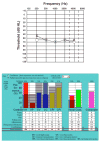
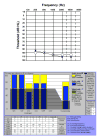
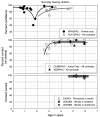
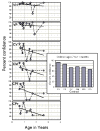
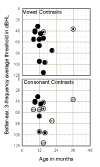
References
-
- Yoshinaga-Itano C, Sedey AL, Coutler DK, Mehl AL. Language of early- and later-identified children with hearing loss. Pediatr. 1998;5:1161–1171. - PubMed
-
- Moeller MP. Early intervention and language development in children who are deaf and hard of hearing. Pediatr. 2000;106:1–9. - PubMed
-
- Johnson KC, Winter ME. Audiologic assessment of infants and toddlers. Volta Rev. 2003;103:221–251.
-
- Seewald RC, Cornelisse LE, Ramji KV, Sinclair ST, Moodie KS, Jamieson DG. DSL v4.1 for Windows: A software implementation of the desired sensation level (DSL[i/o] method for fitting linear gain and wide-dynamic-range compression hearing instruments. Hearing Health Care Research Unit, The University of Western Ontario; London Ontario, Canada: 1997.
-
- Aslin RN, Smith LB. Perceptual development. Ann Rev Psychol. 1988;39:435–473. - PubMed
Publication types
MeSH terms
Grants and funding
LinkOut - more resources
Full Text Sources
Medical
Miscellaneous

